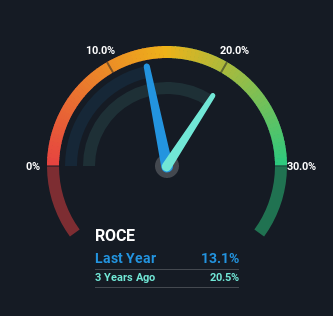- Hong Kong
- /
- Specialty Stores
- /
- SEHK:6909
Returns On Capital At BetterLife Holding (HKG:6909) Paint A Concerning Picture

Finding a business that has the potential to grow substantially is not easy, but it is possible if we look at a few key financial metrics. Amongst other things, we'll want to see two things; firstly, a growing return on capital employed (ROCE) and secondly, an expansion in the company's amount of capital employed. Put simply, these types of businesses are compounding machines, meaning they are continually reinvesting their earnings at ever-higher rates of return. Having said that, from a first glance at BetterLife Holding (HKG:6909) we aren't jumping out of our chairs at how returns are trending, but let's have a deeper look.
Understanding Return On Capital Employed (ROCE)
Just to clarify if you're unsure, ROCE is a metric for evaluating how much pre-tax income (in percentage terms) a company earns on the capital invested in its business. The formula for this calculation on BetterLife Holding is:
Return on Capital Employed = Earnings Before Interest and Tax (EBIT) ÷ (Total Assets - Current Liabilities)
0.13 = CN¥449m ÷ (CN¥5.0b - CN¥1.6b) (Based on the trailing twelve months to June 2022).
Thus, BetterLife Holding has an ROCE of 13%. On its own, that's a standard return, however it's much better than the 11% generated by the Specialty Retail industry.
See our latest analysis for BetterLife Holding

Above you can see how the current ROCE for BetterLife Holding compares to its prior returns on capital, but there's only so much you can tell from the past. If you'd like to see what analysts are forecasting going forward, you should check out our free report for BetterLife Holding.
What Can We Tell From BetterLife Holding's ROCE Trend?
On the surface, the trend of ROCE at BetterLife Holding doesn't inspire confidence. Around three years ago the returns on capital were 21%, but since then they've fallen to 13%. On the other hand, the company has been employing more capital without a corresponding improvement in sales in the last year, which could suggest these investments are longer term plays. It's worth keeping an eye on the company's earnings from here on to see if these investments do end up contributing to the bottom line.
On a side note, BetterLife Holding has done well to pay down its current liabilities to 32% of total assets. So we could link some of this to the decrease in ROCE. What's more, this can reduce some aspects of risk to the business because now the company's suppliers or short-term creditors are funding less of its operations. Since the business is basically funding more of its operations with it's own money, you could argue this has made the business less efficient at generating ROCE.
The Bottom Line
To conclude, we've found that BetterLife Holding is reinvesting in the business, but returns have been falling. Since the stock has declined 42% over the last year, investors may not be too optimistic on this trend improving either. All in all, the inherent trends aren't typical of multi-baggers, so if that's what you're after, we think you might have more luck elsewhere.
One more thing: We've identified 3 warning signs with BetterLife Holding (at least 1 which is concerning) , and understanding these would certainly be useful.
While BetterLife Holding isn't earning the highest return, check out this free list of companies that are earning high returns on equity with solid balance sheets.
Valuation is complex, but we're here to simplify it.
Discover if BetterLife Holding might be undervalued or overvalued with our detailed analysis, featuring fair value estimates, potential risks, dividends, insider trades, and its financial condition.
Access Free AnalysisHave feedback on this article? Concerned about the content? Get in touch with us directly. Alternatively, email editorial-team (at) simplywallst.com.
This article by Simply Wall St is general in nature. We provide commentary based on historical data and analyst forecasts only using an unbiased methodology and our articles are not intended to be financial advice. It does not constitute a recommendation to buy or sell any stock, and does not take account of your objectives, or your financial situation. We aim to bring you long-term focused analysis driven by fundamental data. Note that our analysis may not factor in the latest price-sensitive company announcements or qualitative material. Simply Wall St has no position in any stocks mentioned.
About SEHK:6909
BetterLife Holding
Provides automobile dealership services with a focus on luxury and ultra-luxury brands in the People’s Republic of China.
Flawless balance sheet with proven track record.


